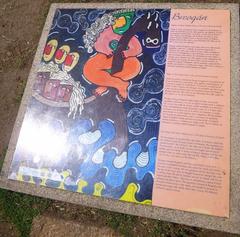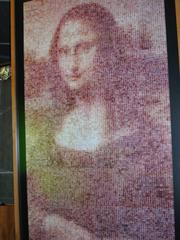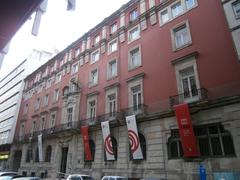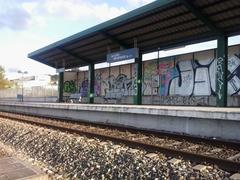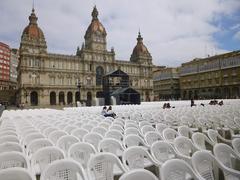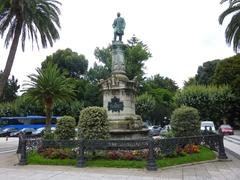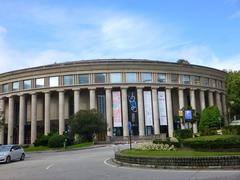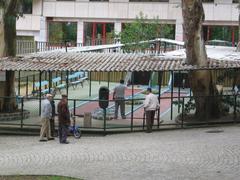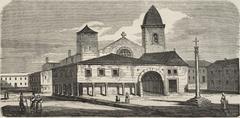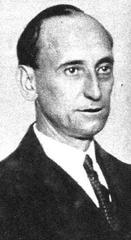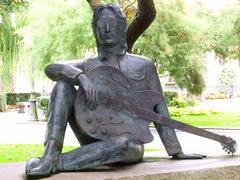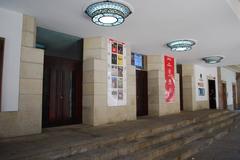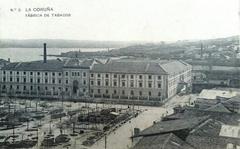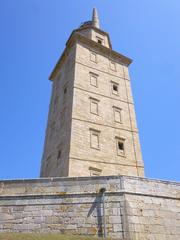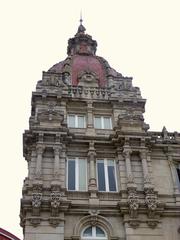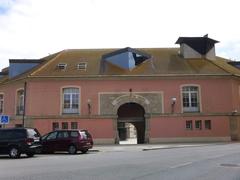
Museum of Sacred Art of Santa María do Campo: Visiting Hours, Tickets, and Complete Guide to A Coruña’s Historical Treasure
Date: 04/07/2025
Introduction: Exploring Galicia’s Sacred Heritage
Located in the historic heart of A Coruña, the Museum of Sacred Art of Santa María do Campo offers an immersive journey into Galicia’s religious, artistic, and maritime past. Housed within the medieval Colegiata de Santa María do Campo—a church with origins in the 12th century—this museum presents a rich collection of sacred art, from Romanesque sculptures and Gothic architecture to Baroque silverwork and illuminated manuscripts. Whether you are an art lover, history enthusiast, or cultural traveler, this guide provides detailed information on visiting hours, ticketing, accessibility, architectural highlights, and practical travel tips for maximizing your experience at one of A Coruña’s most significant historical sites.
Table of Contents
- Historical and Cultural Significance
- Architectural Features and Museum Highlights
- Visitor Information: Hours, Tickets, and Access
- Navigating the Museum: What to See
- Practical Tips and Visitor Experience
- Nearby Attractions and Suggested Itineraries
- Frequently Asked Questions (FAQ)
- Conclusion and Further Resources
- References and Official Links
Historical and Cultural Significance
Origins and Development
The Colegiata de Santa María do Campo was established around 1150, initially outside A Coruña’s original city walls. Its name, “del Campo” (“of the field”), reflects its early rural setting. The church quickly became a spiritual and social hub for the city’s powerful maritime guilds—the “mareantes”—who played a vital role in A Coruña’s medieval economy. Expanded during the 13th and 14th centuries, the church’s architectural evolution mirrors the city’s growing prominence as a port and religious center (Galicia Maxica, Recreación Historia).
Key milestones include its recognition as a parish church by King Alfonso X in 1256 and elevation to collegiate status in 1441 by Archbishop Don Lope de Mendoza (Coruña City Council).
The Museum’s Role
The Museum of Sacred Art, established within the church complex, preserves a remarkable collection of liturgical objects, sculptures, goldsmith work, and manuscripts, offering insight into centuries of religious practice and artistic innovation in Galicia. The museum’s modern annex, designed by Manuel Gallego Jorreto, is a model of sensitive integration with the city’s historic urban landscape (Museos de Galicia).
Architectural Features and Museum Highlights
Romanesque and Gothic Elements
The church’s architecture exemplifies the transition from Romanesque to Gothic styles. Its original Romanesque structure, with three naves and a simple plan, was later enhanced with Gothic features such as pointed arches and a prominent rose window. Inside, 15th-century columns, a Baroque bell tower, and the preserved main chapel from the 12th century create a harmonious blend of styles (Spain.info).
Artistic and Decorative Treasures
- Liturgical Silverwork: Highlights include a late 17th-century German Baroque monstrance, a Eucharistic chest gifted by Queen Mariana of Neuburg, and works by local silversmith Jacobo Pecul.
- Sculptures and Altarpieces: Romanesque and Gothic sculptures, polychrome wood figures of saints, Renaissance and Baroque retablos, and the revered statue of the Virgen del Rosario.
- Paintings and Manuscripts: Panel paintings from the 15th–16th centuries, illuminated choir books, and ecclesiastical documents tracing the evolution of religious art and practice.
Integration with A Coruña’s Old Town
Situated in the Plaza de Santa María del Campo, the church and museum are surrounded by historic landmarks such as the Cornide Palace and the oldest stone cross (cruceiro) in Galicia (Galicia Maxica). The museum’s contemporary annex complements the medieval setting while providing accessibility and modern facilities.
Recognition
Declared a Bien de Interés Cultural in 1931, the church and museum are protected as key elements of Galicia’s heritage (Coruña City Council).
Visitor Information: Hours, Tickets, and Access
Location and Transportation
Address: Plaza de Santa María del Campo, Calle Damas 24, 15001 A Coruña, Spain
The museum is easily reached on foot from the city center and is well-connected by public transport. Nearby parking is limited; public lots are available but fill quickly (Turismo da Coruña).
Museum Visiting Hours
- Current Schedule (2025):
- Tuesday–Friday: 09:00–14:00
- Saturday: 10:00–13:00
- Closed Sundays and Mondays (Museos de Galicia)
Note: Hours may vary seasonally or on holidays. For updated information, check the Museos de Galicia website.
Tickets and Admission
- Admission: Free entry. No ticket purchase required.
Accessibility
- The museum annex is fully accessible, featuring ramps and adapted restrooms.
- Some areas within the historic church may be less accessible due to steps and narrow passages. Visitors with mobility needs are encouraged to contact the museum in advance for assistance.
Guided Tours and Special Events
- Occasional guided tours and educational programs are available; inquire via the museum’s official channels or upon arrival.
- Special events and temporary exhibitions may be held during religious festivals or city heritage days.
Navigating the Museum: What to See
Main Areas
- Nave and Chapels: Display medieval tombs, polychrome sculptures, and historic altarpieces.
- Exhibition Cases: Feature liturgical silverwork, embroidered vestments, and rare manuscripts.
- Atrium: Houses a late 15th-century cruceiro, a hallmark of Galician religious art.
- Main Altar: Showcases repoussée silver and unique goldsmith pieces.
Visitor Highlights
- Romanesque Virgin and Child: 13th-century polychrome wood sculpture.
- Gothic Altarpiece of the Passion: Multi-panel retablo with expressive figures.
- Silver-Gilt Processional Cross: 16th-century masterpiece blending Gothic and Renaissance elements.
- Illuminated Choir Book: 15th-century manuscript with elaborate initials.
- Baroque Saint James: Lifelike wooden statue reflecting pilgrimage traditions.
Exhibits and Interpretation
- Thematic and chronological organization helps visitors trace the development of Galician religious art.
- Multilingual interpretive panels and occasional interactive displays enhance understanding.
Practical Tips and Visitor Experience
- Best Time to Visit: Weekday mornings outside of mass times are quieter.
- Dress Code: Modest attire is recommended; the site is an active place of worship.
- Photography: Allowed without flash in most areas; restricted during services or in sensitive collections.
- Duration: Allow 30–60 minutes for a comprehensive visit.
- Languages: Most signage is in Spanish and Galician; English-speaking staff may not always be available—translation apps are helpful.
Amenities
- Restrooms: Available in the modern annex.
- Gift Shop: Limited; guidebooks or small religious souvenirs may be available at the parish office.
- Guided Tours: Can be arranged for groups or special interest visitors.
Nearby Attractions and Suggested Itineraries
- Cornide Palace: 17th-century Baroque residence opposite the church (Recreación Historia).
- Historic Quarter: Explore traditional Galician architecture, shops, and cafés.
- Other Sites: Church of Santiago, María Pita House Museum, Tower of Hercules, and Castle of San Antón.
Combine your visit to the museum with a walking tour of A Coruña’s Old Town for a full day immersed in history and culture.
Frequently Asked Questions (FAQ)
Q: What are the museum’s visiting hours?
A: Tuesday–Friday: 09:00–14:00; Saturday: 10:00–13:00; closed Sundays and Mondays.
Q: Is there an admission fee?
A: No, admission is free for all visitors.
Q: Are guided tours available?
A: Yes, but they are offered occasionally and by prior arrangement.
Q: Is the museum accessible for visitors with disabilities?
A: The modern annex is fully accessible; some historic areas may present challenges.
Q: Can I take photographs?
A: Yes, photography is generally allowed without flash, except during services or in restricted sections.
Q: What other attractions are nearby?
A: Cornide Palace, Church of Santiago, María Pita House Museum, and the historic quarter.
Conclusion and Further Resources
The Museum of Sacred Art of Santa María do Campo is a must-visit destination for those seeking to understand the depth of Galicia’s religious and artistic legacy. With its blend of Romanesque architecture, medieval treasures, and modern museography, the museum offers a memorable and educational experience at the heart of A Coruña’s historic quarter. Plan your visit, explore the surrounding old town, and enrich your journey with further resources and digital guides.
For updated details on hours, events, and guided tours, consult the official Museos de Galicia and Turismo da Coruña websites.
Download the Audiala app for personalized cultural itineraries and follow us on social media for the latest updates and travel inspiration.
References and Official Links
- Galicia Maxica: Colegiata de Santa María do Campo
- Recreación Historia: Colegiata de Santa María do Campo, A Coruña
- Coruña City Council: Colegiata de Santa María do Campo
- Museos de Galicia: Museo de Arte Sacro Santa María do Campo
- Spain.info: Collegiate Church of Santa María do Campo
- Turismo da Coruña: Colegiata de Santa María do Campo
- Elespanol: Santa María do Campo, singular colegiata en pleno centro de A Coruña
- Explorial: A Coruña – Colexiata de Santa María do Campo
- Make A Bucket List: Things to do in La Coruña, Spain



